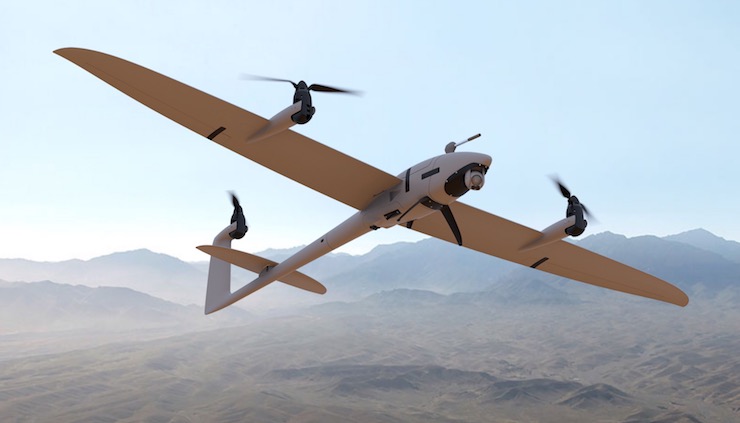Quantum-Systems Drone Company Offers Long Range Flight Options With One Drone Offering a Two Hour Flight Time!

In 2010, Florian Seibel, Dr Michael Kriegel and Tobias Kloss were working as research assistants at the Bundeswehr University in Munich, Germany. Part of their duties involved using UAVs for scientific research. They soon learned that they all shared a common interest in other aeronautical fields like gliding, helicopters, and model planes. Influenced by the work they were doing at the university and their private hobbies, they decided to come together to build transition flight systems for drones. In 2015 they founded Quantum-Systems GmbH out of Bavaria and have gone on to create some of the most innovative drones in the market.
With high hopes Quantum-Systems brought their first prototype to Dubai for the annual Drones for Good competition, a competition that awards designers on positive drone applications. At the largest competition of it’s kind, Quantum-Systems was competing against more that 800 applicants from around the world for a grand prize of $1 million. As novices in the commercial drone sector Quantum-Systems shocked everyone when they won second place with their drone, Quantum TRON. Winning this award gave them the confidence to move forward and gave them the publicity they needed to do so. Today, as stated on their website, Quantum-Systems is “specialized in the development and production of autonomous transition aircrafts for civilian use. Our products combine reach and efficiency with the ability to vertically take off and land without additional equipment.”
All of the drones built by Quantum-Systems offer long range flight options through the combination of aerodynamic and electrical efficiency with the highest grade lithium battery technology. The drones liftoff and land vertically, like a helicopter, but glide like an airplane. This means there is no need for a runway and the drones are able to conserve energy while in flight. All of these innovative design features allow for their drones to support larger than normal payloads. “We offer the highest quality sensors currently available and give you the flexibility to add new payloads as your needs change. The payload compartment can also be adapted to individual requirements.” the website goes on to state. All of the drones are also operated by the software they created called QBase3D.
QBase3D allows the user to plan the flight mission ahead of time, then “automatically generates efficient flight paths after the flight area and the mission parameters have been defined with a few clicks. These steps allow you to be up and flying in no-time with our powerful and easy-to-use software. You are in complete control over your photogrammetric aerial survey mission and guaranteed full coverage over the area of interest.” It gives real time data response as well as keeping the pilot informed of altitude, battery life, speed, and heading at all times. For redundancy the system makes sure that the mission can be carried out safely for the coordinates planned, and the drone’s system capabilities. Once a mission is complete QBase3D pairs up with Delair to compile and process all collected data seamlessly and efficiently.
Currently Quantum-Systems features four drone models. The Vector and Scorpion are both aimed for tactical and government use. The fixed wing Vector can fly through extreme weather conditions, maneuvering in any direction, all with minimal noise output. It has a flight time of 120 minutes and an encrypted mesh IP link to send HD video data within a 15km range. It is perfectly situated for a wide range of military missions. The Scorpion is an option available to branch off of the Vector in which the fixed wings can be removable for a smaller, stealthier drone that can gain access to areas with more limited space. However, since there are no fixed wings for gliding when in Scorpion mode it can only remain airborne for 45 minutes.
The other two drones they offer are the Trinity F90+ and the Tron F90+, both made for surveying and mapping for the fields of agriculture, mining, construction, and inspection. Both are fixed winged drones that have vertical liftoff and landing combined with gliding capabilities. These features allow them to boast industry leading flight times of 90 minutes with an additional payload of just under 5lbs. They coordinate with QBase3D and iBase, a system that is “an entry level GNSS reference station. It automatically logs GNSS reference measurements on the ground to a file on a micro SD card. This file enables QBase3D to do PPK processing of the collected survey data with a absolute accuracy of 2 – 5 cm.” PPK is the post-processing kinematics that takes all the collected data and turns it into actionable mapping resources. Though they are very similar, both can be customized to meet mission specifications. One main difference though, is that the Tron can also carry cargo.
For a company that has been in the market for only a short while, Quantum-Systems is rapidly claiming their spot in the drone hierarchy. With smart designs, long flight times, multiple mission options, and affordable variations they are clearly listening to what consumers are looking for. As Quantum-Systems proudly says, “The combination of innovative power and uncompromising focus on quality make us the first choice in the area of transition flight.”
|